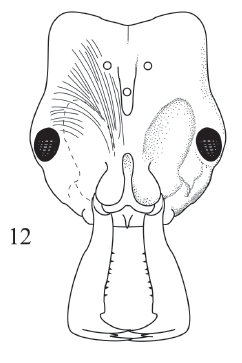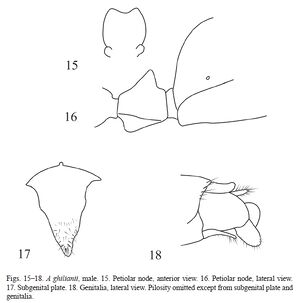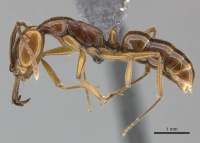Anochetus ghilianii
| Anochetus ghilianii | |
|---|---|

| |
| Scientific classification | |
| Kingdom: | Animalia |
| Phylum: | Arthropoda |
| Class: | Insecta |
| Order: | Hymenoptera |
| Family: | Formicidae |
| Subfamily: | Ponerinae |
| Tribe: | Ponerini |
| Genus: | Anochetus |
| Species: | A. ghilianii |
| Binomial name | |
| Anochetus ghilianii (Spinola, 1851) | |
| Synonyms | |
| |
The biology of A. ghilianii is poorly known, but based on Tinaut et al. (2011) and its similarity with other species in the genus, it is considered to be a species with partially endogean habits, hence its presence closer to the ground surface when the soil is humid. However, individuals are frequently found in leaf litter samples in Gibraltar, indicating that some foraging occurs above the soil surface. Since these samples are taken during daytime, it is evident that foraging is at least partly diurnal. The presence of workers on the soil surface is corroborated by visual records and pitfall trapping.
Individuals and colonies of A. ghilianii are most frequently found under rocks, especially large ones, although a nest entrance was found at the base of a grass tussock in Gibraltar. On the Iberian side of the Strait, the species shows a preference for open or matorral habitats (both the lower, garigue type matorral and the tall, dense maquis) but appears to avoid true woodland and forest. We have not recorded it higher than 390m in Gibraltar (GUILLEM & BENSUSAN, 2009) or Spain. It appears to tolerate higher elevations in Morocco: we encountered A. ghilianii at 670m within cork oak Quercus suber forest in Bouhachem in the western Rif and CAGNIANT (2006) reported it from Bab Taza in the Rif (ca. 950m) and in the middle Atlas. (Tinaut et al., 2011)
Identification
Keys including this Species
- Key to Anochetus of the Mediterranean and Middle East
- Key to the Anochetus of Africa, Spain and Madagascar
Distribution
Anochetus ghilianii is the only species of the genus Anochetus found in Europe.
Tinaut et al. (2011) - Anochetus ghilianii has long been held to be endemic to both shores of the Strait of Gibraltar. On the Iberian Peninsula, it is only known from a thin stretch of land in close proximity to the coast in Cádiz province and Gibraltar. Based on our results following many years of sampling in southern Iberia, including intensive surveying from 1982-1988 (TINAUT, 1989) and 2008-2009 (see TINAUT RANERA et al., in press), the distribution of this species appears to be limited to the area of Cádiz province between the Barbate river in the west and the Guadiaro river in the east, as well as Gibraltar. It does not appear to penetrate any further north than the parallel at 36º 15’: it only occurs south of Vejer de la Frontera (Atlantic coast) and Sotogrande (mediterranean coast). Within this area, it is frequently encountered near the coast, especially during the wetter months of the year between the autumn and spring. Its distribution in northern Morocco is more widespread. Although most records are centred on the Tangier Peninsula, more recent records show that the species is also present from the Rif to the middle Atlas and along the Atlantic Littoral south to Sidi Bettache (CAGNIANT, 2006; corresponding to 33º34’06” N, 6º53’29” W; UTm: 29S 0695722/3716287).
Latitudinal Distribution Pattern
Latitudinal Range: 36.233555° to 32.249974°.
| North Temperate |
North Subtropical |
Tropical | South Subtropical |
South Temperate |
- Source: AntMaps
Distribution based on Regional Taxon Lists
Palaearctic Region: Gibraltar, Iberian Peninsula, Morocco, Spain (type locality).
Distribution based on AntMaps
Distribution based on AntWeb specimens
Check data from AntWeb
Countries Occupied
| Number of countries occupied by this species based on AntWiki Regional Taxon Lists. In general, fewer countries occupied indicates a narrower range, while more countries indicates a more widespread species. |

|
Estimated Abundance
| Relative abundance based on number of AntMaps records per species (this species within the purple bar). Fewer records (to the left) indicates a less abundant/encountered species while more records (to the right) indicates more abundant/encountered species. |

|
Biology
Jowers et al. (2015) - The distribution of A. ghilianii is rather odd. It is the only Anochetus species occurring in Europe and is found on both sides of the Strait of Gibraltar. Its distribution and habitat preferences are quite different in Europe and Africa. In the Iberian Peninsula it is restricted to the stretches of land in close proximity to the coast of Cadiz and Gibraltar, and within these localities the populations seem restricted by river systems (Barbate and Guadiaro Rivers at the west and east, respectively). Their habitat conditions here are mainly associated with low altitude (up to 390 m) (Tinaut et al., 2011a; Tinaut, Ruano, & Martinez, 2011c) humid conditions in open or shrub habitats and leaf litter, avoiding true woodland. In contrast, in Morocco A. ghilianii shows a widespread distribution along the Atlantic coast from Tangier to Ben Slimane and along the Mediterranean coast up to Laou River (collected by AT), tolerating high altitudes (up to 1000 m and oak forest habitat) (Cagniant, 2006).
The occurrence of wingless queens in A. ghilianii and field observations (Taheri, pers. observ.) suggest that this species is likely to disperse by foot (i.e. fission). This in turn should lead to an increase in population structure and promoting an isolation by distance pattern at a local scale. Its distribution on both sides of the 14 km strait suggests they are either a). an ancient lineage, dating to prior to at least the last connection period between both Spain and Africa around 5 million years ago b). have been passivel dispersed more recently, presumably via marine dispersal (rafting on floating vegetation and logs) and/or through accidental human introductions.
Evidence from a rapidly evolving mitochondrial gene (COI) sampled from several individuals throughout the species’ Moroccan and Iberian distribution range shows there is decreasing haplotypic diversity from southern to northern localities. The same haplotype is present for all the Iberian localities and from Cap Spartel and Tangier in North Morocco, suggesting multiple reoccurring translocations through maritime traffic between ports on either side of the Strait of Gibraltar.
Clues on this species’ dispersal mode derive from morphological examination of the only four reported queens to date (Tinaut, Bensusan, & Guillem, 2011b) suggesting, as in other queens within the genus (Brown, 1978; Tinaut & Ruano, 1992), complete absence of wings indicating their inability to fly and therefore their incapability to colonize or re-colonize from either side of the Strait (Tinaut, Bensusan, & Guillem, 2011b). The four A. ghilianii queens described from Spain were accompanied by 20-30 workers, thus indicative of very small nests (Tinaut et al., 2011b). Because Anochetus nests are found a few centimetres from the surface, or as reported with A. ghillianii, present under rocks and leaf litter, it is possible to assume that whole nests have been transported across the sea in building material such as sand, soil, boulders and woods or most likely in planted flowerpots. Furthermore, a dependent colony-founding queen (through fission) needs part of the colony to survive and thus single or multiple queen colonization events are extremely unlikely.
Castes
 
| |
| . | |
Nomenclature
The following information is derived from Barry Bolton's Online Catalogue of the Ants of the World.
- ghilianii. Odontomachus ghilianii Spinola, 1851b: 55 (w.) SPAIN.
- Type-material: 4 syntype workers.
- Type-locality: Spain: Andalusia, 1842 (V. Ghiliani).
- Type-depository: MRSN.
- [Also described as new by Spinola, 1853: 71.]
- Emery, 1909c: 376 (q.m.); Tinaut, et al. 2011: 161 (q.).
- Combination in Anochetus: Mayr, 1861: 54 (in key).
- Status as species: Smith, F. 1858b: 79; Roger, 1859: 245; Mayr, 1861: 54 (in key); Roger, 1861a: 23; Mayr, 1862: 712; Roger, 1863b: 21; Mayr, 1863: 394; Dours, 1873: 166; André, 1874: 188 (in key); Emery & Forel, 1879: 455; André, 1882b: 231 (in key); Emery, 1884a: 378 (in key); Saunders, E. 1890: 203; Dalla Torre, 1893: 47; Emery, 1909c: 375; Forel, 1909c: 103; Emery, 1911d: 108; Crawley, 1920a: 163; Emery, 1924c: 164; Santschi, 1931a: 2; Santschi, 1936c: 198; Ceballos, 1956: 295; Brown, 1964d: 214; Collingwood & Yarrow, 1969: 55; Brown, 1978c: 556, 598; Collingwood, 1978: 75 (in key); Bolton, 1995b: 64; Cagniant, 2006a: 195; Kugler & Ionescu, 2007: 297 (in key); Tinaut, et al. 2011: 161; Borowiec, L. 2014: 8; Lebas, et al. 2016: 400.
- Senior synonym of cameroni: Brown, 1964d: 214; Brown, 1978c: 556, 598; Bolton, 1995b: 64.
- Distribution: Gibraltar, Morocco, Spain.
- cameroni. Anochetus cameroni Forel, 1915c: 352 (w.) BRAZIL (no state data).
- Type-material: syntype workers (number not stated).
- Type-locality: Brazil: Cap Saint- Roque (M. Cameron) (received from Donisthorpe).
- [Note: Brown, 1964d: 214, points out that the Brazil locality is in error, and that the type-locality, on the specimen label as “C.S. Roque”, is most probably “San Roque, Spain, near Gibraltar”, which is within the normal range of ghilianii.]
- Type-depository: MHNG.
- Junior synonym of ghilianii: Brown, 1964d: 214; Brown, 1978c: 556; Bolton, 1995b: 64.
Taxonomic Notes
Brown (1964) notes that while the type locality for A. cameroni was given by Forel (1915) as "Cap Saint-Roque", Brazil, this is apparently in error; the true type locality is probably San Roque, Spain, near Gibraltar. Brown treated A. cameroni as a junior synonym of A. ghilianii. Forel had suggested a close relationship between these two species, stating that they differed in the shape of the petiolar scale and width of the head. However these differences are apparently of little taxonomic significance and the two taxa are considered to belong to a single species.
Description
References
- Borowiec, L. 2014. Catalogue of ants of Europe, the Mediterranean Basin and adjacent regions (Hymenoptera: Formicidae). Genus (Wroclaw) 25(1-2): 1-340.
- Brown, W. L., Jr. 1964m. Synonymy and variation of some species of the ant genus Anochetus. J. Kans. Entomol. Soc. 37: 212-215 (page 214, senior synonym of cameroni)
- Brown, W. L., Jr. 1978c. Contributions toward a reclassification of the Formicidae. Part VI. Ponerinae, tribe Ponerini, subtribe Odontomachiti. Section B. Genus Anochetus and bibliography. Studia Entomologica. 20:549-638. (page 598, see also)
- Emery, C. 1909d. Beiträge zur Monographie der Formiciden des paläarktischen Faunengebietes. (Hym.) Teil VIII. Dtsch. Entomol. Z. 1909: 355-376 (page 376, queen, male described)
- Jowers, M. J., A. Taheri, and J. Reyes-Lopez. 2015. The ant Anochetus ghilianii (Hymenoptera, Formicidae), not a Tertiary relict, but an Iberian introduction from North Africa: Evidence from mtDNA analyses. Systematics and Biodiversity. 13:865-874. doi:10.1080/14772000.2015.1061065
- Mayr, G. 1861. Die europäischen Formiciden. Nach der analytischen Methode bearbeitet. Wien: C. Gerolds Sohn, 80 pp. (page 54, Combination in Anochetus)
- Spinola, M. 1851b. Compte rendu des Hyménoptères inédits provenants du voyage entomologique de M. Ghiliani dans le Para en 1846. Extrait des Mémoires de l'Académie des Sciences de Turin (2) 13: 3-78 (page 55, worker described)
- Spinola, M. 1853. Compte rendu des Hyménoptères inédits provenants du voyage entomologique de M. Ghiliani dans le Para en 1846. Mem. R. Accad. Sci. Torino (2) 13: 19-94 (page 71, also described as new)
- Taheri, A., Reyes-Lopez, J.L. 2023. New and additional records for the ant fauna (Hymenoptera, Formicidae) of Morocco. Journal of the Entomological Research Society 25(1): 1-10 (doi:10.51963/jers.v25i1.1995).
- Taheri, A., Reyes-Lopez, J.L., Bennas, N. 2015. Faible niveau d’agressivité intraspécifique chez les colonies d’Anochetus ghilianii (Spinola, 1851) (Hymenoptera: Formicidae) au Rif occidental (Nord-Ouest du Maroc). Ecoscience 22: 157-165 (doi:10.1080/11956860.2016.1171963).
- Tinaut, A., Ruano, F. 2021. Biogeography of Iberian ants (Hymenoptera: Formicidae). Diversity 13, 88. (doi:10.3390/d13020088).
- Tinaut, A.; Bensusan, K.; Guillem, R. 2011. Redescription of the queen of Anochetus ghilianii (Spinola, 1851) (Hymenoptera, Formicidae). Boletín de la Asociación Española de Entomologia 35(1-2):157-167.
References based on Global Ant Biodiversity Informatics
- André, E.. "Species des Hyménoptères d'Europe et d'Algérie. Les fourmis." in: André, Edm. 1881-1886. Species des Hyménoptères d'Europe et d'Algérie. Tome Deuxième. Beaune: Edmond André, 919 + 48 pp. Tomo II (1881): 1016.
- Borowiec L. 2014. Catalogue of ants of Europe, the Mediterranean Basin and adjacent regions (Hymenoptera: Formicidae). Genus (Wroclaw) 25(1-2): 1-340.
- Brown Jr., W.L. 1978. Contributions toward a reclassification of the Formicidae. Part VI. Ponerinae, Tribe Ponerini, Subtribe Odontomachiti, Section B. Genus Anochetus and Bibliography. Studia Entomologia 20(1-4): 549-XXX
- Brown W. L. Jr. 1964. Synonymy and variation of some species of the ant genus Anochetus. Journal of the Kansas Entomological Society 37: 212-215.
- Brown W. L., Jr. 1964. Synonymy and variation of some species of the ant genus Anochetus. J. Kans. Entomol. Soc. 37: 212-215.
- Cagniant, H. 2006. Liste actualisée des fourmis du Maroc. Myrmecologische Nachrichten 8: 193-200.
- Cagniant, H.. "Liste actualisee des fourmis du Maroc (Hymenoptera: Formicidae)." Myrmecologische Nachrichten 8 (2006): 193-200.
- Cagniant, H.. "Étude de quelques fourmis marocaines. Statistique provisoire des Formicidae du Maroc." Bulletin de la Société d' Histoire naturelle de l' Afrique du Nord 53 (1964): 83-118.
- Emery C. 1911. Hymenoptera. Fam. Formicidae. Subfam. Ponerinae. Genera Insectorum 118: 1-125.
- Emery, C., and A. Forel. "Catalogue des Formicides d'Europe." Mitteilungen der Schweirzerischen Entomologischen Gesellschaft 5 (1879): 441-481.
- Emery, C.. "Beiträge zur Monographie der Formiciden des paläarktischen Faunengebietes. (Hym.) Teil VIII. Ponerinae." Deutsche Entomologische Zeitschrift 1909 (1909): 355-376.
- Emery, C.. "Hymenoptera. Fam. Formicidae. Subfam. Ponerinae." en Wytsman, P. "Genera Insectorum" 118 (1911): 1-124.
- Forel A. 1915. Formicides d'Afrique et d'Amérique nouveaux ou peu connus. IIe partie. Bulletin de la Société Vaudoise des Sciences Naturelles. 50: 335-364.
- Kirchner, L.. "Catalogus Hymenopterorum Europae." Viena (1867).
- Kugler J., and A. Ionescu. 2007. Anochetus bytinskii, a new ant species from Israel (Hymenoptera: Formicidae).Israel Journal of Entomology 37: 287-298.
- Martínez Ibáñez, M. D., and X. Espadaler. "Revisión de las hormigas ibéricas de la colección M. Medina y nuevos datos de distribución." Actas de las VIII Jornadas de la Asociación Española de Entomología (1986): 1022-1034.
- Mayr, G.. "Formicidarum index synonymicus." Verhandlungen der Kaiserlich-Königlichen Zoologisch-Botanischen Gesellschaft in Wien 13 (1863): 385-460.
- Mayr, G.. "Myrmecologische Studien." Verhandlungen der Kaiserlich-Königlichen Zoologisch-Botanischen Gesellschaft in Wien 12 (1862): 649-776.
- Medina, M.. "Catálogo provisional de las hormigas de Andalucía." Actas de la Sociedad Española de Historia Natural 20 (1891): 95-104.
- Roger, J.. "Beiträge zur Kenntniss der Ameisenfauna der Mittelmeerländer. I." Berliner Entomologische Zeitschrift 3 (1859): 225-259.
- Roger, J.. "Die Ponera-artigen Ameisen." Berliner Entomologische Zeitschrift 4 (1860): 278-312.
- Santschi, F.. "Inventa entomologica itineris Hispanici et Maroccani, quod a. 1926 fecerunt Harald et Håkan Lindberg. Fourmis du Bassin Méditerranéen occidental et du Maroc récoltées par MM. Lindberg." Societas Scientiarum Fennica (Helsingfors) 3 (14) (1931): 1-13.
- Saunders, E.. "Aculeate Hymenoptera collected by J. J. Walker, at Gibraltar and in North Africa. (Part I - Heterogyna)." Entomologists' Monthly Magazine XXVI (1890): 201-206 y 289-291.
- Taheri A., J. Reyes-Lopez, and N. Bennas. 2014. Contribution a l'etude de la fauna myrmecologique du parc national de Talassemtane (nord du Maroc): biodiversite, biogeographie et especes indicatrices. Boletín de la Sociedad Entomológica Aragonesa (S.E.A.), 54: 225236.
- de Haro, Andrés, and C. A. Collingwood. "Prospección mirmecológica por la península Tingitana al norte del Rif (Marruecos)." Orsis (Organismes i Sistemes) 12 (1997): 93-99.

